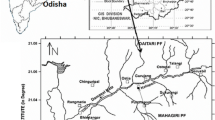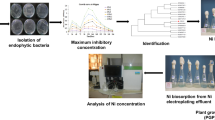Abstract
Soils around the electroplating industry are often polluted with metals. The aim of the study was to assess Cr(VI) adsorption potential of chromium-resistant bacteria isolated from soil samples collected in and around electroplating industry, Coimbatore, India. A total of six morphologically different chromium-resistant bacteria were isolated from the soil samples and assayed for resistance to Cr(VI). Isolate designated SS-1 exhibited maximum resistance to Cr(VI) (600 mg/l) and subsequently identified as Bacillus subtilis based on the morphology, phenotypic characters, and partial 16S rDNA sequences. Batch experiments were carried out as a function of time, initial Cr(VI) concentration (100 mg/l), pH (2), and biosorbent dose (0.1 g/l). The maximum percentage of Cr(VI) removal was found to be 98.7 %. The experimental data showed a better fit with Langmuir model over Freundlich model throughout the range of initial concentrations. The kinetic models were examined with pseudo-first-order and pseudo-second-order kinetics. Fourier transform infrared spectroscopy studies confirmed the involvement of carboxyl and amide groups in Cr(VI) adsorption. Scanning electron microscopic studies revealed that nature of the bioadsorbent was altered after Cr(VI) adsorption. The results revealed that Cr(VI) was considerably adsorbed onto bacterial biomass, and it could be an economical method for the removal of Cr(VI) from aqueous solution.












Similar content being viewed by others
References
Aroua MK, Owlad M, Daud WAW, Baroutian S (2009) Removal of hexavalent chromium-contaminated water and wastewater: a review. Water Air Soil Pollut 200:59–77
Autuner APM, Watkins GM, Duncan JR (2001) Batch studies on the removal of gold(III) from aqueous solution by Azolla filiculoides. Biotechnol Lett 23:249–251
Bergey DH, Holt JG (1994) Bergey’s manual of determinative bacteriology. Williams & Wilkins, Baltimore
Chiou MS, Li HY (2003) Adsorption behavior of reactive dye in aqueous solution on chemical cross-linked chitosan beads. Chemosphere 50:1095–1105
Cordero B, Loderio P, Herrero R, de-Vicente MES (2004) Biosorption of cadmium by Fucus spiralis. Environ Chem 1:180–187
Davis TA, Volesky B, Mucci A (2003) A review of the biochemistry of heavy metal biosorption by brown algae. Water Res 37:4311–4330
Fitch WM (1971) Toward defining the course of evolution: minimum change for a specific tree topology. Syst Zool 20:406–416
Hassen A, Saidi N, Cherif M, Boudabous A (1998) Resistance of environmental bacteria to heavy metals. Bioresour Technol 64:7–15
Janaki V, Oh BT, Shanthi K, Lee KJ, Ramasamy AK, Kamala-Kannan S (2012a) Polyaniline/chitosan composite: an eco-friendly polymer for enhanced removal of dyes from aqueous solution. Synth Met 162:974–980
Janaki V, Vijayaraghavan K, Oh BT, Lee KJ, Muthuchelian K, Ramasamy AK, Kamala-Kannan S (2012b) Starch/polyaniline nanocomposite for enhanced removal of reactive dyes from synthetic effluent. Carbohydr Polym 90:1437–1444
Kamala-Kannan S, Krishnamoorthy R (2006) Isolation of mercury resistant bacteria and influence of abiotic factors on bioavailability of mercury—a case study in Pulicat Lake north of Chennai, south east India. Sci Total Environ 367:341–353
Kamala-Kannan S, Lee KJ (2008) Metal tolerance and antibiotic resistance of Bacillus sp. isolated from Suncheon Bay sediments, South Korea. Biotechnology 7:149–152
Kamaludeen SP, Arunkumar KR, Avudainayagam S, Ramasamy K (2003) Bioremediation of chromium contaminated environments. Indian J Exp Biol 41:972–985
Kowalski Z (1994) Treatment of chromic tannery wastes. J Hazard Mater 37:137–144
Kumar S, Tamura K, Nei M (2004) MEGA 3: integrated software for molecular evolutionary genetics analysis and sequence alignment. Brief Bioinform 5:150–163
Liu YG, Xu WH, Zeng GM, Li X, Gao H (2006) Cr(VI) reduction by Bacillus sp. isolated from chromium landfill. Process Biochem 41:1981–1986
Loukidou MX, Karapantsios TD, Zouboulis AI, Matis KA (2004) Diffusion kinetic study of chromium(VI) biosorption by Aeromonas caviae. Ind Eng Chem Res 43:1748–1755
Mabbett AN, Macaskie LE (2001) A novel isolate of Desulfovibrio sp. with enhanced ability to reduce Cr(VI). Biotechnol Lett 23:683–687
Maniatis T, Fritsch EF, Sambrook J (1989) Molecular cloning: a laboratory Manual, 2nd edn. Cold Spring Harbor Laboratory Press, Cold Spring Harbor
Nomanbhay SF, Palanisamy K (2005) Removal of heavy metal from industrial wastewater using chitosan coated oil palm shell charcoal. Electron J Biotechnol 8:44–53
Oh BT, Hur H, Lee KJ, Shanthi K, Soh BY, Lee WJ, Myung H, Kamala-Kannan S (2011) Suppression of Phytophthora blight on pepper (Capsicum annuum L.) by bacilli isolated from brackish environment. Biocontrol Sci Technol 21:1297–1311
Sağ Y, Kutsal T (1989) Application of adsorption isotherms to chromium adsorption on Z. ramigera. Biotechnol Lett 11:141–144
Saitou N, Nei M (1987) The neighbor-joining method: a new method for reconstructing phylogenetic trees. Mol Biol Evol 4:406–425
Shanker AK, Venkateswarlu B (2011) Chromium. In: Nriagu JO (ed) Environmental pollution, health effects and mode of action. Encyclopedia of environmental health. Elsevier Science, USA, pp 650–659
Shin MN, Shim J, You Y, Myung H, Bang KS, Cho M, Kamala-Kannana S, Oh BT (2012) Characterization of lead resistant endophytic Bacillus sp. MN3-4 and its potential for promoting lead accumulation in metal hyperaccumulator Alnus firma. J Hazard Mater 199–200:314–320
Sudha BR, Abraham E (2001) Biosorption of Cr(VI) from aqueous solution by Rhizopus nigrificans. Bioresour Technol 79:73–81
Vijayaraghavan K, Yun YS (2008) Bacterial biosorbents and biosorption. Biotechnol Adv 26:266–291
Wang J, Chen C (2009) Biosorbents for heavy metals removal and their future. Biotechnol Adv 27:195–226
Zayed AM, Terry N (2003) Chromium in environment: factors affecting biological remediation. Plant Soil 249:139–156
Zhou M, Liu Y, Zeng G, Li X, Xu W, Fan T (2007) Kinetic and equilibrium studies of Cr(VI) biosorption by dead Bacillus licheniformis biomass. World J Microbiol Biotechnol 23:43–48
Ziagova M, Dimitriadis G, Aslanidou D, Papaioannou X, Tzannetaki EL, Liakopoulou-Kyriakides M (2007) Comparative study of Cd(II) and Cr(VI) biosorption on Staphylococcus xylosus and Pseudomonas sp. in single and binary mixtures. Bioresour Technol 98:2859–2865
Author information
Authors and Affiliations
Corresponding authors
Rights and permissions
About this article
Cite this article
Sukumar, C., Janaki, V., Kamala-Kannan, S. et al. Biosorption of chromium(VI) using Bacillus subtilis SS-1 isolated from soil samples of electroplating industry. Clean Techn Environ Policy 16, 405–413 (2014). https://doi.org/10.1007/s10098-013-0636-0
Received:
Accepted:
Published:
Issue Date:
DOI: https://doi.org/10.1007/s10098-013-0636-0




